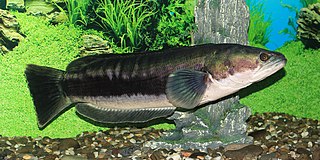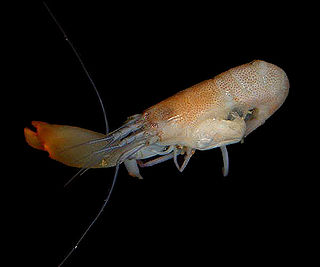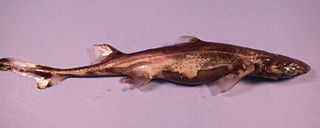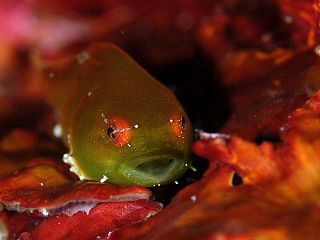
Scyliorhinus is a genus of catsharks in the family Scyliorhinidae. This genus is known in the fossil records from the Cretaceous period, late Albian age to the Pliocene epoch.

The Cyclopteridae are a family of marine fishes, commonly known as lumpsuckers or lumpfish, in the order Scorpaeniformes. They are found in the cold waters of the Arctic, North Atlantic, and North Pacific oceans. The greatest number of species are found in the North Pacific. The family name Cyclopteridae derives from the Greek words κύκλος (kyklos), meaning "circle", and πτέρυξ (pteryx), meaning "wing" or "fin", in reference to the circle-shaped pectoral fins of most of the fish in this family.

Channa is a genus of predatory fish in the family Channidae, commonly known as snakeheads, native to freshwater habitats in Asia. This genus contains about 50 scientifically described species. The genus has a wide natural distribution extending from Iraq in the west, to Indonesia and China in the east, and parts of Siberia in the Far East. A particularly high richness of species exists in Myanmar (Burma) and northeastern India, and many Channa species live nowhere else. In contrast, a few widespread species have been introduced to several regions outside their natural range, where they often become invasive. The large and medium-sized Channa species are among the most common staple food fish in several Asian countries, and they are extensively cultured. Apart from their importance as a food fish, snakeheads are consumed in some regions as a traditional medicine for wound healing and reducing postoperative pain and discomfort, and collected for the international aquarium pet trade.

Dwarf snakehead is a term coined by aquarists to describe a group of Channa snakehead fishes growing to about 25 cm (10 in) maximum. They are found in freshwater habitats in South and Southeast Asia, and southern China.

Danio is a genus of small freshwater fish in the family Cyprinidae found in South and Southeast Asia, commonly kept in aquaria. They are generally characterised by a pattern of horizontal stripes, rows of spots or vertical bars. Some species have two pairs of long barbels. Species of this genus consume various small aquatic insects, crustaceans and worms.

Synalpheus is a genus of snapping shrimp of the family Alpheidae, presently containing more than 160 species; new ones are described on a regular basis, and the exact number even of described species is disputed.

Etmopterus is a genus of lantern sharks in the squaliform family Etmopteridae. They are found in deep sea ecosystems of the Atlantic, Indian and Pacific Oceans.
The Cypriot mouse is a species of mouse endemic to Cyprus. Its primary habitat seems to be the vineyards and fields of the Troödos Mountains region.

The Inyo shrew is a species of shrew found in the western United States. It is light gray and white in color, with a narrow skull and small body size, very similar in appearance to the related dwarf shrew, but paler and not as large. It can be found in many different habitats, from rocky, mountainous regions to wetlands and riparian areas. Not much is known about its behavioral and reproductive habits. While barely studied, their population is believed to be stable and not under any threat.

Cambarellus is a genus of small freshwater crayfish in the family Cambaridae. The 19 species are found in Mexico and the Gulf States of the United States. Among the Mexican species, C. areolatus, C. patzcuarensis, and C. prolixus are considered seriously threatened by the IUCN, and C. alvarezi is already extinct. C. chihuahuae was also believed to be extinct until rediscovered in 2012. C. alvarezi and four undescribed, extinct Cambarellus species were restricted to desert spring systems in southwestern Nuevo León; each one shared its habitat with a Cyprinodon pupfish.

Eumicrotremus is a genus of lumpfishes native to the northern oceans. The name for this genus comes from the Greek roots eu meaning "good", mikros meaning "small" or "little", and trema meaning "hole".

Lethotremus is a monospecific genus of marine ray-finned fish belonging to the family Cyclopteridae, the lumpfishes or lumpsuckers. This genus is found in the northern Pacific Ocean. Following a 2017 taxonomic review by Lee et al., the species Lethotremus awae was reclassified as a species of Eumicrotremus, leaving the genus monotypic with Lethotremus muticus as its only species. Also known as the docked snailfish, is a species of lumpfish native to the Northeast Pacific. It is known from the Bering Sea and the Aleutian Islands, where its range extends to Unimak Pass, and it occurs at a depth range of 58 to 330 m. It is a benthic species that reaches 11.5 cm in total length. It can be found on substrates of mud, rock, or gravel, and it is currently the only known species of Lethotremus, following a reclassification of the second described species in the genus as Eumicrotremus awae.

Minous, is a genus of marine ray-finned fishes, it is the only genus in the tribe Minoini, one of the three tribes which are classified within the subfamily Synanceiinae within the family Scorpaenidae, the scorpionfishes and their relatives. They are commonly known as stingfishes. They are found in the Indo-West Pacific.

Cryptodifflugiidae is a family of arcellinid testate amoebae.

The greater Azores bullfinch was a large, extinct species of bullfinch in the family Fringillidae that was once endemic to the Azores. It is the first known extinct passerine to be described from the islands. It is the largest known member of its genus based on its skull size, and had a very robust beak reminiscent of that of a parrot. However, the remains are otherwise reminiscent of the extant but highly endangered Azores bullfinch.

Eumicrotremus awae is a species of lumpfish endemic to the Pacific coast of Honshu, Japan, where it may be found from Chiba to Mie. It is a very small fish, reaching a maximum of 2 cm (0.8 in) SL, and it occurs near shore at depths of less than 20 m (66 ft). This species is variable in color, being typically seen as either vibrant green or red. It is known to feed on extremely small crabs, and was previously known as Lethotremus awae until it was reclassified in 2017 following a taxonomic review and the descriptions of two similar "dwarf" species in Eumicrotremus.

Eumicrotremus pacificus, sometimes known as the spotted lumpsucker or the balloon lumpfish, is a species of lumpfish native to the Northwest Pacific. It can be found in the Sea of Okhotsk, the Sea of Japan, the East China Sea, and the Pacific Ocean off Hokkaido and the Kuril Islands. It may be confused with the closely related Eumicrotremus orbis, which overlaps with E. pacificus in range, although E. pacificus is larger, reaching 20 cm (7.9 inches) TL. This fish is generally yellow to orange in color with small dark spots and its tubercles are usually smaller and less pronounced than E. orbis, giving it a less spiny appearance.
Eumicrotremus schmidti is a species of lumpfish native to the Northwest Pacific. It is a demersal fish known only from the northern Sea of Okhotsk, where it is found at a depth range of 20 to 143 m. Specimens of E. schmidti were once attributed to the related species E. andriashevi, which does not inhabit the Sea of Okhotsk. This species was first formally described in 1955 by the Soviet ichthyologists Georgii Ustinovich Lindberg and Marina Iosifovna Legeza with its type locality given as Penzhinskaya Bay in the Sea of Okhotsk in Russia. The identity of the person honoured in the specific name was not given by Lindberg and Legeza but it is likely to be Petr Yulievich Schmidt, a Russian ichthyologist.
Eumicrotremus uenoi is a species of lumpfish native to the Northwest Pacific. It is found off the Korean Peninsula and Japan, where it occurs at a depth range of 90 to 100 m. It is a very small demersal fish, reaching 2 cm SL. The species was named after Dr. Tatsuji Ueno, formerly of the Hokkaido Fisheries Experimental Station, in honor of his work with the systematics of Cyclopteridae, the lumpfishes. It was described in 2017 following a taxonomic review of "dwarf" lumpfishes that also resulted in the description of Eumicrotremus jindoensis and the reclassification of the species Lethotremus awae as Eumicrotremus awae.
Eumicrotremus tokranovi is a species of lumpfish native to the Northwest Pacific, and one of two species some authorities place in the genus Microancathus. It is known from the Kuril Islands. It is distinguished from the closely related E. fedorovi by a taller body and flatter and less developed bone plaques. FishBase does not recognize the genus Microancathus,. This species was described by the Russian ichthyologist Olga Stepanovna Voskoboinikova in 2015 in the proposed new genus, Microancathus and the reclassification of M. fedorovi in that genus. Catalog of Fishes does not recognize the new genus and classifies this species in Eumicrotremus. The specific name honors the ichthyologist Alexei Mikhailovich Tokranovof the Kamchatka Branch of the Pacific Institute of Geography and the Far East Branch of the Russian Academy of Sciences.















